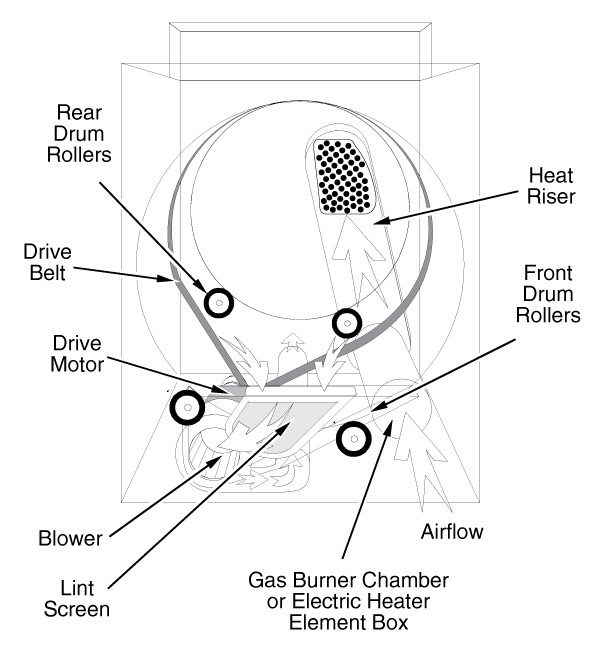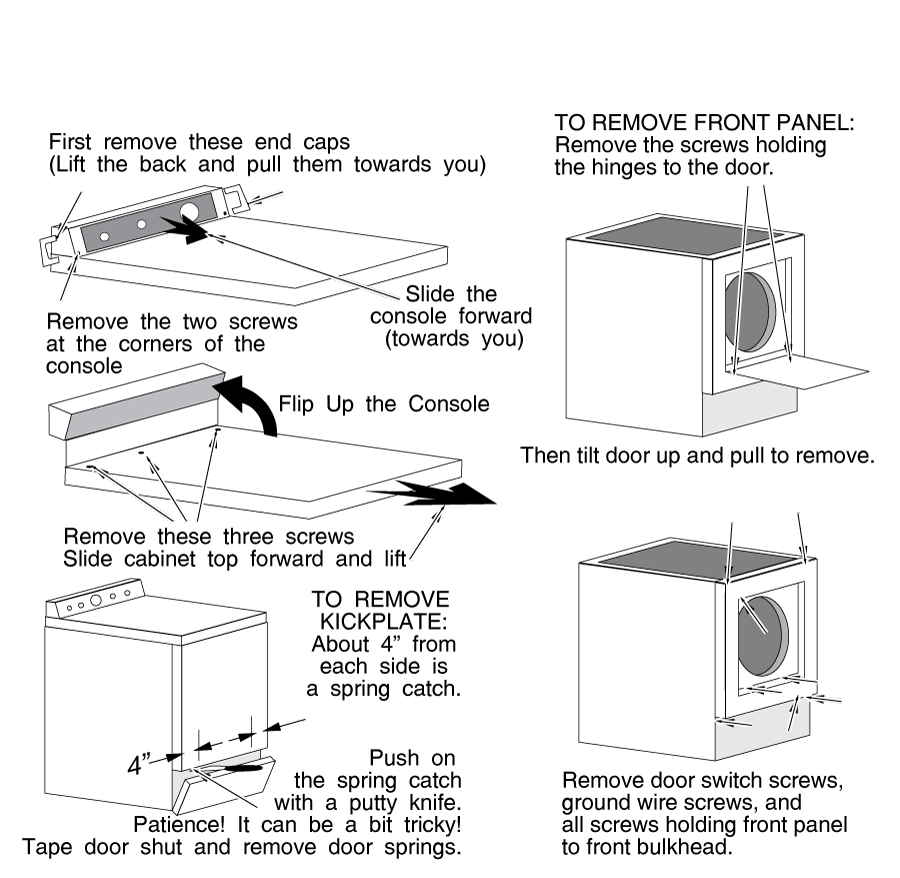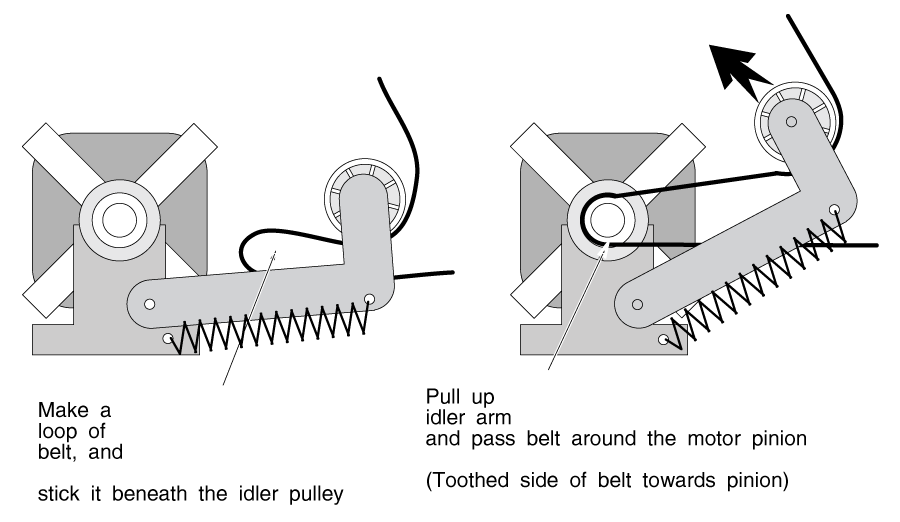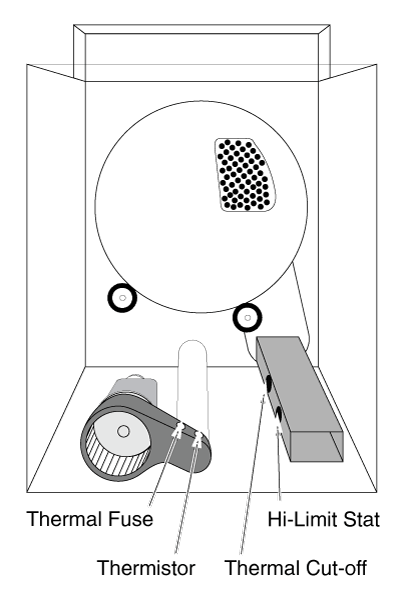Whirlpool & Kenmore 27″ Models
NOTE: Chapter 2 covers problems common to almost all dryer designs, like drive belt and heating problems. This chapter covers only diagnosis and repairs peculiar to Kenmore and Whirlpool-built machines.
If you do not read Chapter 2 thoroughly before you read this chapter, you probably will not be able to properly diagnose your Whilpool or Kenmore dryer!
Note that Whirlpool makes two different dryers. This chapter applies if the cabinet of your dryer is 27 inches wide. If your dryer is 29 inches wide, see chapter 3.
Figure WA-1 shows the general layout of these machines.
The drum is supported by rollers; two at the front and two at the rear.

The blower fan is attached directly to the rear of the drive motor. The drive belt comes directly off the front of the motor and goes completely around the drum.
The three most common problems in these machines are:
1) Noisy operation, usually a loud rumbling sound getting progressively worse over time, caused by worn drum support rollers. Usually this appears in machines about 7-15 years old. To replace the rollers, remove the drum as described in section 3a-3.
2) No heat, caused by a broken ignitor. See chapter 2, section 2-3(a) to replace.
3) There is a "broken belt switch" in these machines, also known as a "dead switch." Electrically, this switch is in series with the drive motor. If the belt breaks, the motor will not run.
If you hear a loud, regular clackety-clacking as the dryer drum is turning, and you do not have any metal zippers or buttons inside the drum, some coins may have gotten inside the vanes. Look inside the dryer drum; the three tumbling vanes will be plastic. Turn the drum until the plastic vane is on top. Open the top of the cabinet as shown in figure WA-2. Remove the screws that hold the vane in place and remove any coins that have gotten in the vanes.
Figure WA-2 shows how to remove the cabinet access panels on this machine. There are a couple of tricks to disassembling these machines.
The console must be flipped up to get to the screws that secure the top of the cabinet.

The spring catches on the kickplate can be a bit tricky to remove. It helps to know that the catches are mounted on the kickplate and not on the front panel; to disengage the clip, you push down on it with a putty knife.
Once you get the cabinet front panel off, reach under the drum to the back of the drive motor and remove the belt from the motor pinion to release belt tension. The front bulkhead and drum can then be easily removed.
The four drum support rollers will now be easily accessible. One or two may be worn more than the others, but replace them all. When replacing, use only ONE drop of oil on the hub. Oil tends to attract dust and lint, and over-oiling them can actually shorten the life of them.
While you have the dryer dismantled, vacuum out all the dust you can. Also, it's a good idea to replace the belt and belt tensioner whenever you have the dryer dismantled to this point. It is cheap insurance against future problems.
Inspect the front and rear drum seals (attached to the front and back of the dryer drum).
If they are badly worn, replace them. Your parts dealer will have a seal kit, and it is actually quite inexpensive and easy to glue a new one in place.
Re-assembly is basically the opposite of disassembly.
Installing the belt can be a bit tricky. The idler and motor pulley are on the back side of the motor on these machines. When the drum and front bulkhead are in place, make sure the belt is flat on the drum and closely line up the belt on on the old belt skid mark on the drum. To tension the belt, make a loop of belt and stick it under the tensioner as shown in figure WA-3. Push the tensioner with your thumb and slip the belt loop around the motor pinion with your fingers. Figure WA-3 is a little misleading; the belt, pulley and pinion are on the back side of the motor. But this is the direction you will be pushing the idler with one hand, so the process was shown this way for clarity.
After installing the dryer front, roll the dryer drum around several times by hand. As you turn it, check that the belt is flat all the way around.

The heater element is accessed by removing the kickplate; you do not have to remove the drum.
The heater elements are located inside the square heater box on the right, as you look at the front of the machine. (Figure WA-4) You can test the elements for continuity without removing the heater.

These clothes dryers contain four temperature controls; two on the heater box, and two on the blower outlet.
The two on the blower outlet are a thermal fuse and a thermistor. The thermal fuse is in series with the drive motor and will shut it off if the exhaust air is too hot. The thermistor is actually a variable resistor (see section 2-4(c) that controls the operating temperature of the air inside the drum.
The two on the heater box are a high-limit thermostat and a thermal cut-off. Both prevent overtemperature of the drum by cutting off the heater in the event of overheat. The thermal cut-off acts as a backup for the high-limit thermostat. A high-temperature condition causes it to open, an overheated grounded heat element may also cause it to open.
All four are tested by testing resistance across them; they should show no resistance when cold. Replace if defective.
If you replace the thermal cutoff, you should replace the hi-limit stat, too, whether it tests defective or not.
Please share our .